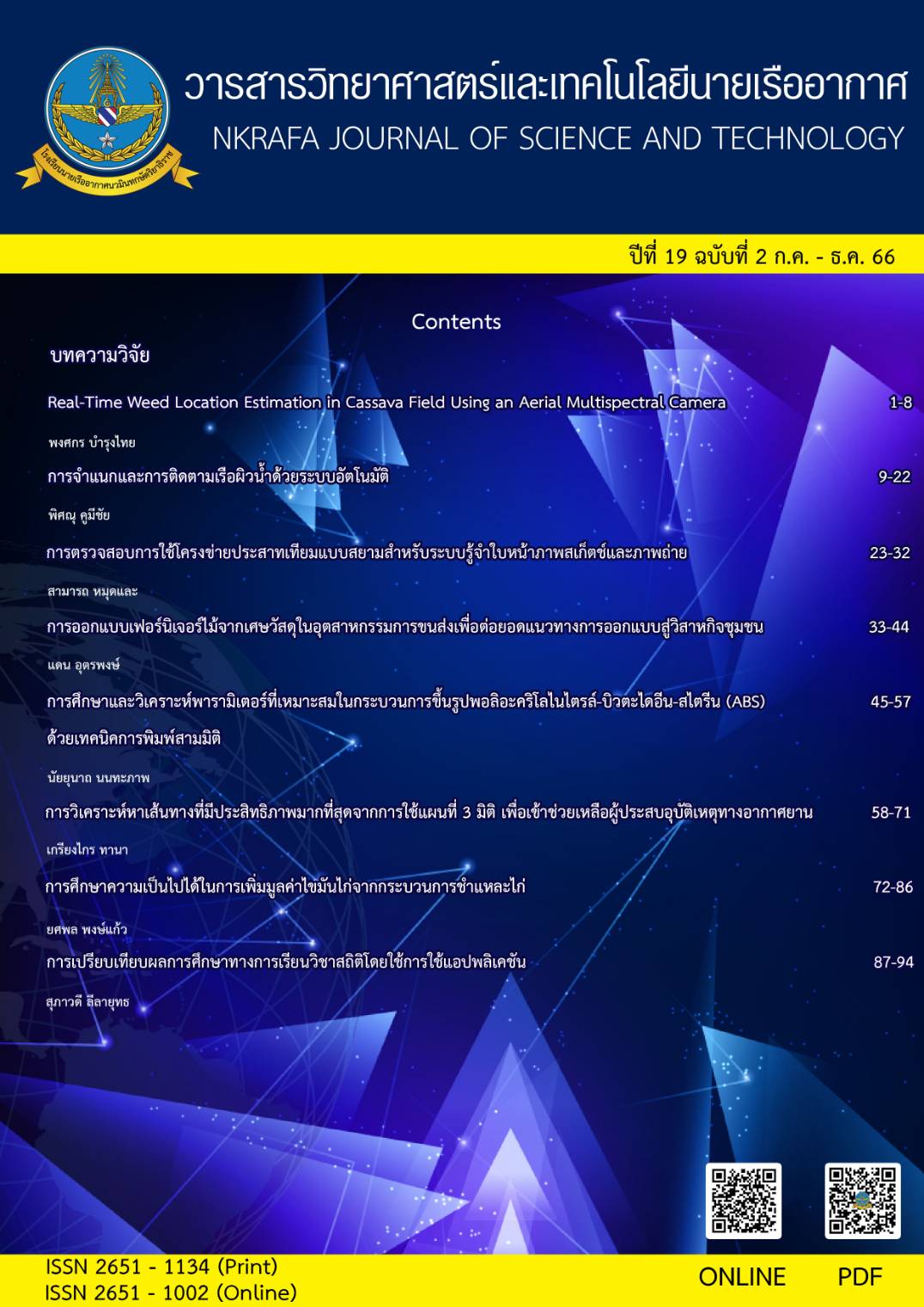Automatic Classification and Tracking of Surface Ships
Main Article Content
Abstract
In surface-based autonomous driving technology, cameras are essential for routing and object detection. to avoid obstacles or avoid boat collisions. The important thing is to track known ship movements. In this paper, the Thai maritime data set is used. and data visualization for the training model. Next, object recognition is presented using the AlexNet method by simulating and evaluating its performance in different maritime environments. It then proposes a tracking algorithm to track specific objects, especially in high-motion video evaluations. The experimental results show that the tracking algorithm outperforms online and real-time tracking in terms of object tracking accuracy.
Article Details

This work is licensed under a Creative Commons Attribution-NonCommercial-NoDerivatives 4.0 International License.
- Content and information in articles published in NKRAFA Journal of Science and Technology are comment and responsibility of authors of articles directly. Journal editorial do no need to agree or share any responsibility.
- NKRAFA Journal of Science and Technology Articles holds the copyright of the content, pictures, images etc. which published in it. If any person or agency require to reuse all or some part of articles, the permission must be obtained from the NKRAFA Journal of Science and Technology.
References
Redmon, J.; Divvala, S.; Girshick, R.; Farhadi A. (2016). You only look once: Unified, real-time object detection. In Proceedings of the IEEE Conference on Computer Vision and Pattern Recognition, Las Vegas, NV, USA, 27–30 June 2016; pp. 779–788.
Zhang, Y.; Wang, C.; Wang, X.; Zeng,W.; Liu,W. Fairmot. (2020). On the fairness of detection and re-identification in multiple object tracking. arXiv 2020, arXiv:2004.01888.
Bewley, A.; Ge, Z.; Ott, L.; Ramos, F.; Upcroft, B. (2016). Simple online and realtime tracking. In Proceedings of the 2016 IEEE International Conference on Image Processing (ICIP), Phoenix, AZ, USA, 25–28 September 2016; pp. 3464–3468.
Wojke, N.; Bewley, A.; Paulus, D. (2017). Simple online and realtime tracking with a deep association metric. In Proceedings of the 2017 IEEE International Conference on Image Processing (ICIP), Beijing, China, 17–20 September 2017; pp. 3645–3649.
Lee, S.J.; Roh, M.I.; Oh, M.J. (2020). Image-based ship detection using deep learning. Ocean. Syst. Eng. 2020, 10, 415–434.
Jie, Y.; Leonidas, L.; Mumtaz, F.; Ali, M. (2021). Ship detection and tracking in inland waterways using improved YOLOv3 and Deep SORT. Symmetry 2021, 13, 308.
Huang, H.; Sun, D.; Wang, R.; Zhu, C.; Liu, B. (2020). Ship target detection based on improved YOLO network. Math. Probl. Eng. 2020, 9440212.
Chen, X.; Qi, L.; Yang, Y.; Luo, Q.; Postolache, O.; Tang, J.; Wu, H. (2020). Video-based detection infrastructure enhancement for automated ship recognition and behavior analysis. J. Adv. Transp. 2020, 7194342.
Chen, X.; Xu, X.; Yang, Y.; Wu, H.; Tang, J.; Zhao, J. (2020). Augmented ship tracking under occlusion conditions from maritime surveillance videos. IEEE Access 2020, 8, 42884–42897.
Girshick, R.; Donahue, J.; Darrell, T.; Malik, J. (2014). Rich feature hierarchies for accurate object detection and semantic segmentation. In Proceedings of the IEEE Conference on Computer Vision and Pattern Recognition, Columbus, OH, USA, 23–28 June 2014; pp. 580–587.
Deriche, R. (1987). Using Canny’s criteria to derive a recursively implemented optimal edge detector. Int. J. Comput. Vis. 1987, 1, 167–187.
Harris, C.; Stephens, M. (1988). A combined corner and edge detector. In Proceedings of the Alvey Vision Conference, Manchester, UK, 31 August–2 September 1988; Volume 15, pp. 10–5244.
Dalal, N.; Triggs, B. (2005). Histograms of oriented gradients for human detection. In Proceedings of the 2005 IEEE Computer Society Conference on Computer Vision and Pattern Recognition (CVPR’05), San Diego, CA, USA, 20– 25 June 2005; pp. 886–893.
Lowe, D.G. Distinctive image features from scale-invariant keypoints. Int. J. Comput. Vis. (2004), 60, 91–110.
Simonyan, K.; Zisserman, A. (2014). Very deep convolutional networks for large-scale image recognition. arXiv 2014, arXiv:1409.1556.
He, K.; Zhang, X.; Ren, S.; Sun, J. (2016). Deep residual learning for image recognition. In Proceedings of the IEEE Conference on Computer Vision and Pattern Recognition, Las Vegas, NV, USA, 27–30 June 2016; pp. 770–778.
Redmon, J.; Farhadi, A. (2017). YOLO9000: Better, faster, stronger. In Proceedings of the IEEE Conference on Computer Vision and Pattern Recognition, Honolulu, HI, USA, 21–26 July 2017; pp. 7263–7271.
Redmon, J.; Farhadi, A. (2018). Yolov3: An incremental improvement. arXiv 2018, arXiv:1804.02767.
Bochkovskiy, A.; Wang, C.Y.; Liao, H.Y.M. (2020). Yolov4: Optimal speed and accuracy of object detection. arXiv 2020, arXiv:2004.10934.
Krizhevsky, A., Sutskever, I., & Hinton, G. E. (2012). Imagenet classification with deep convolutional neural networks. In Advances in neural information processing systems (pp. 1097-1105).
Artificial Neural Networks. (2566). (อาทฟิคเคล นิวรอล เน็ตเวริค) คืออะไร โครงข่ายประสาทเทียม. (ออนไลน์). สืบค้นเมื่อ 9 เมษายน 2566, แหล่งที่มา https://shorturl.asia/PYZ2v.
LeCun, Y., Bottou, L., Bengio, Y., & Haffner, P. (1998). Gradient-based learning applied to document recognition. Proceedings of the IEEE, 86(11), 2278-2324.
Krizhevsky, A., Sutskever, I., & Hinton, G. E. (2012). ImageNet classification with deep convolutional neural networks. In Advances in neural information processing systems (pp. 1097-1105).
Alexnet architecture. (2566). Alexnet architecture (ออนไลน์). สืบค้นเมื่อ 9 เมษายน 2566, แหล่งที่มา https://shorturl.asia/BD9rC.


